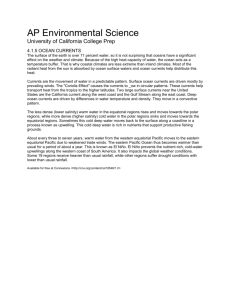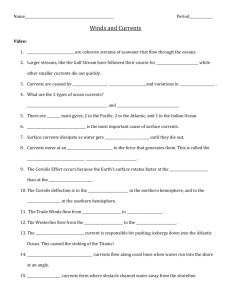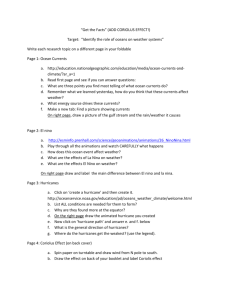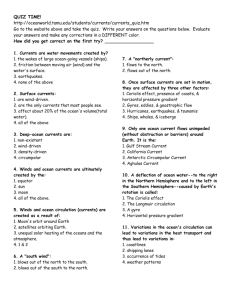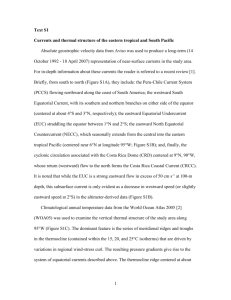notes her
advertisement
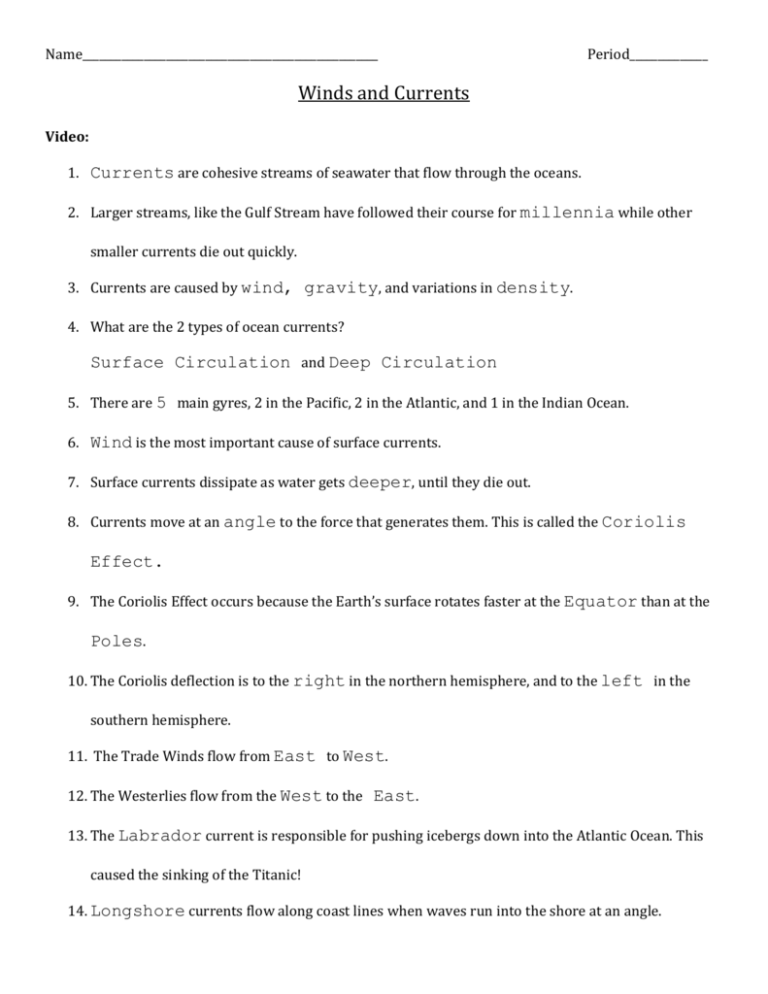
Name_____________________________________________________ Period______________ Winds and Currents Video: 1. Currents are cohesive streams of seawater that flow through the oceans. 2. Larger streams, like the Gulf Stream have followed their course for millennia while other smaller currents die out quickly. 3. Currents are caused by wind, gravity, and variations in density. 4. What are the 2 types of ocean currents? Surface Circulation and Deep Circulation 5. There are 5 main gyres, 2 in the Pacific, 2 in the Atlantic, and 1 in the Indian Ocean. 6. Wind is the most important cause of surface currents. 7. Surface currents dissipate as water gets deeper, until they die out. 8. Currents move at an angle to the force that generates them. This is called the Coriolis Effect. 9. The Coriolis Effect occurs because the Earth’s surface rotates faster at the Equator than at the Poles. 10. The Coriolis deflection is to the right in the northern hemisphere, and to the left in the southern hemisphere. 11. The Trade Winds flow from East to West. 12. The Westerlies flow from the West to the East. 13. The Labrador current is responsible for pushing icebergs down into the Atlantic Ocean. This caused the sinking of the Titanic! 14. Longshore currents flow along coast lines when waves run into the shore at an angle. 15. Rip currents form where obstacles channel water away from the shoreline. 16. Upwelling occurs when winds push surface water away from the shore. Deeper water rises to fill the gap left behind. 17. Deep currents twist together into a continuous stream called the Global Conveyer Belt. 18. As polar water freezes salt is left behind. This causes the water to become more dense, so it sinks. 19. Surface water is pulled in above the dense, cold salt water. 20. Two currents split off near Antarctica, one to the Indian Ocean, and one to the Pacific Ocean. 21. As these currents move North they get warmer and lose salt making them less dense. 22. This causes them to rise back to the surface. Coriolis Effect: Which Target Do You Chose? What Was the Correct Target? 1. ____________________ ______________________ 2. ____________________ ______________________ 3. ____________________ ______________________ 4. ____________________ ______________________ El Nino: 1. Compare sea temperatures in the Eastern and Western sides of the Pacific under normal conditions. The seawater on the surface in the eastern Pacific is much colder, and cools off with depth much faster. On the west side, there is an enormous blob of warm water that is right on the surface and also extends hundreds of meters down. The surface of the sea is irregular all across the Pacific, but there is a broad mound on the western side. 2. Knowing that the Tradewinds flow from East to West, explain how they create this temperature pattern. The trade winds blow most of the time in the tropics, and start the Equatorial Currents moving just north and south of the equator. These currents push water from east to west across the Pacific. The land masses on the west side of the sea (Indonesia, the Philippines, New Guinea, etc.) block the currents, and water piles up into a low mound against the land. Seawater in the Equatorial Currents is heated by intense sunlight during the journey across the Pacific, and so is quite warm by the time it reaches the west side. In the east, cold water is flowing toward the equator in the Eastern Boundary Currents, so sea surface temperatures are much cooler on that side of the Pacific. 3. Now compare the temperatures in the Eastern and Western sides of the Pacific during El Nino conditions. During El Nino the surface of the Pacific slopes up toward the east. The temperature of the sea is much warmer all across the Equator, both right at the surface and down several hundred meters. The hottest water is no longer on the west side of the Pacific, but between the center and east edge of the ocean. 4. What would cause this change? It looks as if during El Nino, warm water is flowing across the Pacific instead of west. This could only happen if the Trade Winds were weaker of less steady then normal, which would in turn diminish the strength of the Equatorial Currents. If the forces of wind and water moving west decline, that big mound of hot water that is usually ear Indonesia would collapse, and a lot of it would flow back east in the Equatorial Countercurrents. Warm water would then build up in the eastern Pacific.
